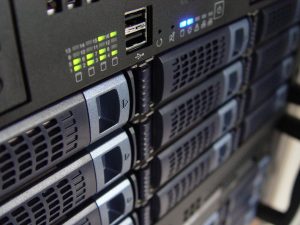Containers are a sort of programming that can bundle and segregate applications for arrangement. Containers can share access to the working framework (OS) portion without customarily requiring a virtual machine (VM). Compartment innovation has established in parceling going back to the 1960s and chroot process separation, which was created as a major aspect of Linux during the 1970s. Its most recent structure is spoken to by application containerization, for example, Docker, and framework containerization, for example, LXC (Linux compartment). Both of these holder styles permit IT, groups to digest application code from the hidden framework, improve form control, and give compactness in different organizational situations. The compartment picture contains data that is executed at runtime on the OS through the holder motor. Containerized applications can comprise of various compartment pictures. For instance, a three-level application can comprise a front-end web server, an application server, and a database compartment, each running freely. Containers are characteristically stateless and don’t hold session data, yet can be utilized for stateful applications. You can run numerous examples of the compartment picture simultaneously, and supplant a bombed occurrence with another one without intruding on your application. Engineers use containers during improvement and testing, and IT tasks groups are progressively conveying creation IT conditions with containers that can run on uncovered metal servers, VMs, and the cloud.
How Containers Work?
Containers hold the parts expected to run the ideal programming. These parts incorporate records, condition factors, conditions, and libraries. The host OS restrains the container’s entrance to physical assets, for example, CPU, stockpiling, and memory, so a solitary container can’t expend the entirety of the host’s physical assets.
Container picture records are finished static and executable renditions of an application or administration, contingent upon the innovation. Docker pictures are comprised of various layers, beginning with the base picture. The base picture contains every one of the conditions expected to execute code on the container. Each picture has a decipherable/writable layer over a static, non-evolving layer. Every container has its particular container layer that modifies that specific container so that the basic picture layer can be put away and reused in different containers. An Open Container Initiative (OCI) picture comprises of a show, a document framework layer, and a design. An OCI picture has two particulars: an execution determination and a runtime detail. The runtime detail diagrams the highlights of a record framework pack, a document that contains every one of the information required for execution and runtime. A picture detail contains the data expected to dispatch an application or administration in an OCI container. The container motor runs the pictures, and numerous associations use container schedulers and coordination advancements to deal with the sending. Each picture contains the conditions expected to execute code in the container, making the container progressively compact. For example, container users can run the same image on an Amazon Web Services (AWS) cloud instance during testing and then run it on a production on-premises Dell server without changing the application code in the container.
Application Container vs. System Container
An application container, for example, Docker, epitomizes the records, conditions, and libraries of the application running on the OS. Clients can utilize application containers to make and run separate containers for various free applications or numerous administrations that make up a solitary application. For instance, application containers are perfect for microservice applications where the administrations that make up the application run freely of one another.
Framework containers, for example, LXC is in fact, like both application containers and VMs. Framework containers can run the OS. Like how the OS is typified and run on a VM. Notwithstanding, framework containers don’t imitate framework equipment. Rather, framework containers carry on comparatively to application containers, enabling clients to introduce various libraries, dialects, and framework databases.
Advantages of Containers
Containers are more efficient than VMs, which require a separate OS instance because the containers share the same OS kernel as the host. Containers are more versatile than other applications facilitating advancements. You can move between frameworks that offer a host OS type without requiring code changes. This embodiment of the application working code inside the container implies that there are no visitor OS condition factors or library conditions to oversee. Containers can be just a couple many megabytes in size, yet the virtual machine size of the whole working framework can be a few gigabytes. This enables a solitary server to have a greater number of containers than virtual machines. Another significant favorable position is that while a virtual machine can take a few minutes to boot the working framework and start running the facilitated application, containerized applications can be propelled quickly. This means that containers can be instantiated just-in-time when needed, disappear when they are no longer needed, and release resources on the host.
The third advantage is that containerization improves modularity. Rather than running the whole mind-boggling application in a solitary container, you can isolate the application into modules (databases, application front finishes, and so on.). This is an alleged microservices approach. Applications manufactured this way are simpler to oversee because every module is generally basic, and you can make changes to modules without revamping the whole application. Since containers are so lightweight, singular modules (or microservices) can be launched just when required and made accessible very quickly.
What is Docker?
Docker is an instrument proposed to make it easy to make, pass on, and run applications using containers. Containers enable engineers to bundle an application that incorporates every essential part; for example, libraries and different conditions and ship them across the board bundle. In doing so, the container allows developers to run applications on other Linux machines, regardless of machine customization settings, which may be different from the machine used to write and test code. It can be relieved in some ways. In any case, in contrast to a virtual machine, instead of making a whole virtual working framework, Docker enables the application to utilize a similar Linux bit as the framework on which it is running, and ships the application with something not previously running on the host PC do it. This greatly improves performance and reduces application size.
Applications of Docker
Reproducibility: Much the same as Java applications that run indistinguishably on gadgets that can run a Java virtual machine, the Docker container is destined to be the equivalent on all frameworks that can run Docker. The definite details of the container are put away in the Dockerfile. By appropriating this record to colleagues, your association can guarantee that all pictures made from the equivalent Dockerfile work the equivalent. Furthermore, a steady and well-archived condition makes it simpler to follow applications and recognize issues.
Isolation: Conditions or settings inside a container don’t influence the establishment or setup of the PC or other running containers. By utilizing a different container for every segment of your application (for example, the webserver, front end, and database that has your site), you can abstain from clashing conditions. You can likewise convey different activities on a solitary server without stressing over framework clashes.
Security: Due to significant contemplations (examined underneath), isolating the various segments of an enormous application into various containers can give security benefits. If one container is undermined, different containers are not influenced.
Docker Hub: For normal or straightforward use cases, for example, a LAMP stack, having the option to spare and push pictures to Docker Hub implies that there are as of now some well-looked after pictures. This kind of setup process is very fast and easy, as you can quickly get pre-built images or build from officially maintained Dockerfiles.
Virtualization
Some of the time, we mistake container innovation for virtual machine (VM) or server virtualization innovation. Even though there are some essential similitudes, Virtualization is different from Containers. Many computers today can run only a single operating system and application, making them inefficient. With virtualization, multiple virtual machines can be placed on a single server, reducing the number of servers and reducing energy and maintenance costs.
To comprehend what virtualization is, you have to recognize what a non-virtualized framework resembles:
Running various working frameworks is anything but another idea. Since the beginning of work area processing, programming engineers have discovered approaches to do this utilizing a boot supervisor or boot loader. Macintosh OS X incorporates Boot Camp, which enables you to introduce a Windows working framework on your Apple machine. The contrast between virtualization programming is that it is a lot more straightforward and simpler procedure, and can run different working frameworks all the while.
Virtualization programming runs like some other application. To begin, turn on your PC, load the virtualization program, and introduce the working framework from an establishment CD, DVD, or .iso record. In virtualization terms, the primary working framework is known as the “have” working framework, and the optional working framework is known as the “visitor” working framework. At the point when the virtualization programming runs, each resulting working framework that you introduce on your PC carries on like another PC. For instance, one PC can run a Linux server, two Windows servers, and three Linux servers. A total of 6 servers (5 guests and one host) can access at the same time. In a network, each server appears as a unique system. These guest systems can run programs and share files that can run on a real computer. But doing everything on one machine can be convenient and cost-saving.
Advantages of Virtualization
Depending on the IT architecture, the nature of the work, and the IT budget, virtualization software can provide different benefits to nonprofits or libraries.
Server consolidation
One of the key advantages of virtualization programming is that it enables you to scale your server foundation without buying extra equipment. This reduces “server sprawl” and makes more efficient use of resources.
Saves energy
Virtualization software saves energy as well as hardware costs. It is broadly accepted that the vitality cost of running a server in a server farm is more noteworthy than the expense of acquiring it. As a result, businesses, especially those offering services in the cloud, are eager to use virtualization to minimize operational costs.
Advance manageability
Overseeing virtual machines is a lot simpler than overseeing genuine machines. For example, a hardware upgrade can be performed using a management console application instead of powering down the machine, installing the hardware, and checking and then turning on the changes. Besides, virtual machine management can often be performed through the same console, reducing the time required to deploy virtual machines.
Lessen backup and retrieval times
Since virtual machines are documents, reinforcement and reestablish times are altogether quicker than running them on independent machines. Likewise, while records can be tremendous, catalogs of numerous documents can be more effectively reestablished than genuine machines of a similar particular. What’s more, equipment disappointments, for example, hard drive disappointments, don’t influence virtual machines similarly as physical machines.
Backing cross-platform office
It isn’t phenomenal for workplaces running for the most part Macs to need to run a couple of Windows-just projects. For this situation, running virtual programming is reasonable and simple. Note, in any case, that the opposite isn’t relevant. Many virtualization applications for PCs can run Linux, but not the Mac operating system. Keep in mind that despite its many benefits, virtualization software is not for everyone. There is an expectation to absorb information to both conceptualize how virtual machines work in systems and associations and oversee them in a dependable and financially savvy way. If the staff is having problems with physical computers, it’s easy to see which machines are guests, which ones are very transparent to the user, and how they affect daily operations.






AffiliateLabz
Great content! Super high-quality! Keep it up! 🙂
finance advice
Have you ever thought about adding a little bit more than just your articles? I mean, what you say is fundamental and all. But think about if you added some great graphics or video clips to give your posts more, “pop”! Your content is excellent but with images and clips, this site could certainly be one of the most beneficial in its niche. Wonderful blog!
Nicolas Lord
Thank you, I’ve just been looking for information about this topic for a long time and yours is the best
I have found out till now. But, what concerning the conclusion? Are you positive about the
supply?